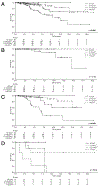Contemporary assessment of extent of resection in molecularly defined categories of diffuse low-grade glioma: a volumetric analysis
- PMID: 31653812
- PMCID: PMC7348099
- DOI: 10.3171/2019.6.JNS19972
Contemporary assessment of extent of resection in molecularly defined categories of diffuse low-grade glioma: a volumetric analysis
Abstract
Objective: While the effect of increased extent of resection (EOR) on survival in diffuse infiltrating low-grade glioma (LGG) patients is well established, there is still uncertainty about the influence of the new WHO molecular subtypes. The authors designed a retrospective analysis to assess the interplay between EOR and molecular classes.
Methods: The authors retrospectively reviewed the records of 326 patients treated surgically for hemispheric WHO grade II LGG at Brigham and Women's Hospital and Massachusetts General Hospital (2000-2017). EOR was calculated volumetrically and Cox proportional hazards models were built to assess for predictive factors of overall survival (OS), progression-free survival (PFS), and malignant progression-free survival (MPFS).
Results: There were 43 deaths (13.2%; median follow-up 5.4 years) among 326 LGG patients. Median preoperative tumor volume was 31.2 cm3 (IQR 12.9-66.0), and median postoperative residual tumor volume was 5.8 cm3 (IQR 1.1-20.5). On multivariable Cox regression, increasing postoperative volume was associated with worse OS (HR 1.02 per cm3; 95% CI 1.00-1.03; p = 0.016), PFS (HR 1.01 per cm3; 95% CI 1.00-1.02; p = 0.001), and MPFS (HR 1.01 per cm3; 95% CI 1.00-1.02; p = 0.035). This result was more pronounced in the worse prognosis subtypes of IDH-mutant and IDH-wildtype astrocytoma, for which differences in survival manifested in cases with residual tumor volume of only 1 cm3. In oligodendroglioma patients, postoperative residuals impacted survival when exceeding 8 cm3. Other significant predictors of OS were age at diagnosis, IDH-mutant and IDH-wildtype astrocytoma classes, adjuvant radiotherapy, and increasing preoperative volume.
Conclusions: The results corroborate the role of EOR in survival and malignant transformation across all molecular subtypes of diffuse LGG. IDH-mutant and IDH-wildtype astrocytomas are affected even by minimal postoperative residuals and patients could potentially benefit from a more aggressive surgical approach.
Keywords: astrocytoma; extent of resection; low-grade glioma; oligodendroglioma; oncology; volumetric analysis.
Figures



References
-
- Aghi MK, Nahed BV, Sloan AE, Ryken TC, Kalkanis SN, Olson JJ: The role of surgery in the management of patients with diffuse low grade glioma: a systematic review and evidence-based clinical practice guideline. J Neurooncol 125:503–530, 2015 - PubMed
-
- Berger MS, Rostomily RC: Low grade gliomas: functional mapping resection strategies, extent of resection, and outcome. J Neurooncol 34:85–101, 1997 - PubMed
-
- Bette S, Kaesmacher J, Huber T, Delbridge C, Ringel F, Boeckh-Behrens T, et al.: Value of early postoperative FLAIR volume dynamic in glioma with no or minimal enhancement. World Neurosurg 91:548–559.e1, 2016 - PubMed
Grants and funding
LinkOut - more resources
Full Text Sources

